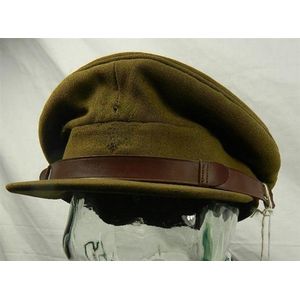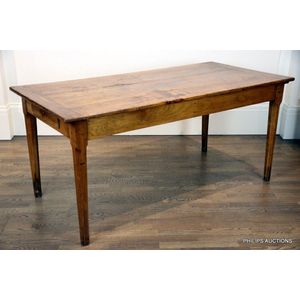19th Century Elm Farmhouse Table
An antique elm farmhouse table, 19th century, the plank top mitred table of pegged construction in honey tones with a fine, patina, a slide to one short end and a single drawer to the other, and raised, on chamfered tapering octagonal legs, height 75 cm, length 166 cm, width 81 cm
You must be a subscriber, and be logged in to view price and dealer details.
Subscribe Now to view actual auction price for this item
When you subscribe, you have the option of setting the currency in which to display prices to $Au, $US, $NZ or Stg.
This item has been sold, and the description, image and price are for reference purposes only.
- Patination / Patina - In broad terms, patination refers to the exterior surface appearance of the timber, the effect of fading caused by exposure to sunlight and air over the course of a century or more, changing the piece to a soft, mellow colour.
As patina is very difficult to replicate, it is one of the most important guides to determining the age of furniture.
Patina is also the term applied to the bloom or film found on old bronzes due to oxidisation. - Octagonal Leg - Octagonal leg, also known as a faceted leg, is usually found on chairs and table pedestals made during the first thirty or forty years of the 19th century, though the design appears in some pattern books dating from the late 18th century. They are not uncommon on Australian colonial furniture of the period. The leg is turned, with the main body of the leg planed into a slightly tapering octagon between the upper and lower turnings. The leg was sometimes fluted or carved with foliage, although in colonial furniture it was more often plain. Octagonal legs are often found on elbow or carver chairs of the period, with scrolled arms sometimes known as Trafalgar chairs.
- Bevel / Chamfer - In furniture making, a chamfered corner refers to a technique used to create a smooth, angled edge on the corner of a piece of furniture. This is typically done by cutting away a small portion of the corner at an angle, typically 45 degrees, creating a diagonal edge, rather than a sharp 90-degree angle. This technique can be used on various parts of a piece of furniture such as table legs, drawer fronts, or door frames. Chamfering can add visual interest to a piece and can help to soften the overall look of a piece of furniture. It is often used in conjunction with other techniques, such as rounding edges or using contrasting wood species to create a more elegant, sophisticated look. Chamfering is a simple way to add a touch of elegance to a piece of furniture and it is a common technique used by furniture makers.
This item has been included into following indexes:
- tables, large dining
Visually similar items

1880's Arts & Crafts side table in cedar and blackwood
Sold by
in
for
You can display prices in $Au, $US, $NZ or Stg.

World War II Army Officers Cap
Sold by
in
for
You can display prices in $Au, $US, $NZ or Stg.

Good Chinese carved bamboo brush pot Ching dynasty
Sold by
in
for
You can display prices in $Au, $US, $NZ or Stg.

Royal Worcester egg cup signed Powell, hand painted kookaburra and wattle decoration
Sold by
in
for
You can display prices in $Au, $US, $NZ or Stg.
